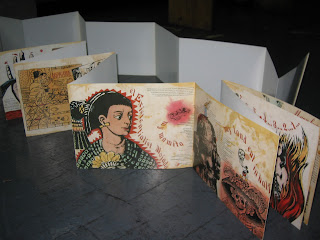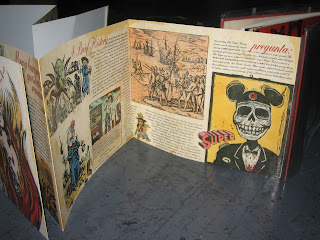We begin with the Pedagogy of Listening, a practice of listening to children talking, and specific to our class, the importance of children talking about art. Aileen stressed, too often teachers may begin with talking, not listening, to what his or her students might have to say. With listening as a method of teaching as our impetus we began the first portion of our class, a critique of our classmate's alphabets. The structure of the critique was set forth as follows: each person's work will be considered for three minutes, there will be a timer, a critique leader, and a note taker. Having only three minutes to discuss each person's work proved difficult, but also set an important parameter. Questions needed to be thoughtfully worded and discussion had to stay focused for there to be any benefit to the artist or the rest of the group.

Were we successful in getting the most out of those three minutes as group? I think mildly so. It was clear to see how easy it is to wander off topic or revert to casual conversation that may not be directly linked to the artwork. After running our critique on our own, without any guidance from Aileen, other than to think about listening, she then offered some suggestions. Cool! Awesome! I like it! Examples of what
not to say at a critique. This language is not enough because it is not helpful to students involved. They may think so, everyone likes to receive a compliment, but a compliment is not a critique. Critique should be viewed as a conversation with a purpose. As a teachers we need to guide students in the right direction, support them with language they can use to talk about art in a constructive way.
Aileen also mentioned the importance of reading your students mood in reference to a critique. Can the student handle a harsh comment right now? The power of words could damage that student's view of the class, you as a teacher, art making, or any number of unfortunate things. A good mantra:
always be on the side of the learner. This idea come from the work of educator,
Herbert Kohl. I acknowledge it's very hard to be a listener, especially when you are trying to explain an art project to a group, But it does hold true that the teacher learns from listening to the student just as the student learns from listening to the teacher. I will also go a step further to express this should be a dialogue between both parties. As a teacher, when you learn what your students' interests are and why they do things as they do, you can begin to bring more context into your teaching. Your teaching can be listening and dialogue as well as beneficial and enjoyable.
Moving away from critique and onto our current in class project which involves making a dystopian graphic novel. We will be creating a narrative along the lines of Cormac Mc Carthy's
The Road. A cataclysmic event depicted not strictly as within a
paracosm, but also linking to real cities and real horrific or cataclysmic events. We find ourselves in a moment where this genre has become popular especially amongst adolescents. Through our books we make in class, we will be linking multiple worlds, that will ultimately offer a vision for working with children on a theme relevant to them at this point in time.
Some artists whose work we discussed or viewed in relation to dystopian themes:
 |
| Christoph Buchel, Last Man Out Turn Off Lights (Installation view) | | | |
 |
| Ai Weiwei, Oil Spills |
 |
| Felix Schramm, Misfit 2005/2006 (Installation view) |

















